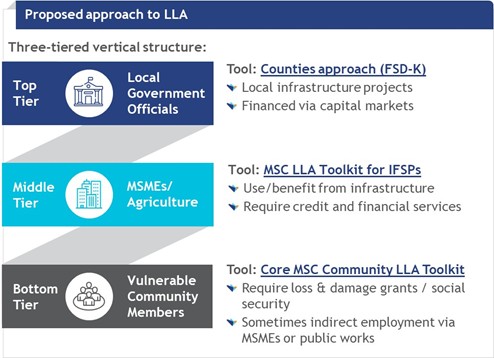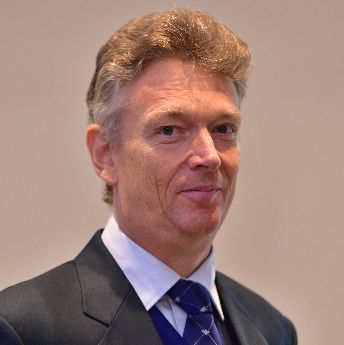A USD-1.5 trillion opportunity: Inclusive finance for climate adaptation
 by Graham Wright, Vikash Kumar Sinha and Akhand Tiwari
by Graham Wright, Vikash Kumar Sinha and Akhand Tiwari Sep 22, 2025
Sep 22, 2025 6 min
6 min
Climate adaptation needs exceed public finance, demanding large-scale private investment. Local governments, MSMEs, farmers, and vulnerable households face rising climate shocks. With financial access already widespread, channeling targeted climate finance into resilient infrastructure, businesses, and households is essential.
In today’s world, we do not have a shortage of ideas for climate adaptation. We have an excess of talk and a shortage of delivery. Public money, while valuable, cannot bridge the massive USD 187–359 billion gap to finance climate adaptation on its own. We need to mobilize private finance at scale. And we need to do it where climate change’s impacts are felt most acutely: In local governments, micro and small enterprises, smallholder farmers, and particularly vulnerable households.
What the need looks like on the ground
The Findex 2025 report highlights what we at MSC have seen for ourselves. Climate shocks are now routine for low-income communities. 35% of adults in low-income countries report that they suffered a natural disaster or weather shock in the past three years. Two-thirds of these adults lost income or assets, while the poorest 40% were one-third more likely to be hit than others.
Yet interestingly, three in four people affected already have an account with a financial service provider. That combination of high exposure and financial access provides a real opportunity to move beyond talk and into action.
If we are to target finance effectively, we must separate local adaptation needs into three distinct but mutually reinforcing buckets:
- Local governments that build resilient infrastructure;
- MSMEs and smallholder farmers who adapt business models and assets; and
- Households that absorb, anticipate, and adapt to shocks.

Local governments: capital at scale, closer to citizens
Counties and municipalities shoulder the work on infrastructure, which includes flood defenses, water systems, heat management, resilient roads, irrigation, and waste-to-value plants. This infrastructure provides the foundation on which MSMEs and agriculture depend. For these projects, local governments need well-structured, long-term finance.
Green municipal bonds, for example, have financed water storage and flood defenses, such as Cape Town’s USD 83 million issue in 2017, which was oversubscribed four times. Meanwhile, Kenya’s County Green Preparation Facility bundles county pipelines, runs feasibility studies, and prepares projects for local capital markets, including potential green bond issuance. Such aggregation reduces transaction costs, raises bankability, and keeps accountability local, without the often-debilitating challenges of foreign exchange risk.
MSMEs and agriculture: the overlooked engine of resilience
In low-income countries, MSMEs and smallholder farmers employ around 70% of the workforce. Yet they receive just around 2% of global climate finance. We cannot afford this mismatch, especially since MSMEs and the agriculture sector are the “missing middle” of climate finance and often provide periodic employment to the most vulnerable households.
The great news is that we already have an effective delivery system in the shape of inclusive financial service providers (IFSPs), which comprise microfinance institutions, cooperatives, banks, and mobile-money providers. IFSPs serve people from the low- and moderate-income segment every day, at scale, with trusted, transparent systems built over the past 50 years. They already lend about USD 1.5 trillion a year to small businesses. We need to use that infrastructure and take advantage of that remarkable private sector capital base for locally-led adaptation … and thus make every climate dollar go further.
MSMEs and smallholder farmers need a range of products that span working capital and capex loans, savings, insurance, and digital payments. With the right tools, they can turn recurrent shocks into manageable risks through investments in drought-tolerant seeds, solar pumps, raised homesteads, boreholes, and engagement in diversified livelihoods.
Blended finance, which comprises first-loss guarantees, concessional credit lines, and derisking insurance, has already unlocked private lending to MSMEs in programs, such as Ghana’s Boosting Green Employment and Enterprise Opportunities. Toolkits are now available to help IFSPs design climate-responsive products for these needs.
Particularly vulnerable households: Social protection plus inclusive finance
The poorest households often lack borrowing capacity and need grants and timely cash to rebuild and adapt. Targeted social protection (including disaster compensation) and community-level adaptation funds are essential. After the shock of COVID-19, governments have been working to digitize payments, cut leakage, and speed up the delivery of help to those in need.
Well-designed programs, such as the KALIA initiative in India’s Odisha state, blend transfers, insurance, and interest-free loans so families can adopt improved seeds and diversify their income. Social protection and inclusive finance are complementary pathways for these people to build resilience.
The hidden $1.5 trillion channel—still mostly climate-agnostic
The network of IFSP worldwide reaches deep into vulnerable communities, knows clients, and already moves money with systems that regulators trust. Three in four adults in low- and moderate-income countries now can access formal financial services.
However, most IFSP lending remains climate-agnostic, which is a significant missed opportunity. Unless we pair scarce public and philanthropic dollars with this channel, we will not be able to take advantage of local capital markets, crowd in private finance, and increase lending for adaptation.
A rising risk we must manage
Ignoring climate risk will not make it go away. MFIs and banks are already seeing higher portfolio-at-risk where floods, droughts, and storms intensify. In Pakistan, after repeated flooding, many MFIs reduced or even stopped lending in the hardest-hit districts. In parts of Africa, MSC’s scenario analysis, based on climate projections, suggests PAR could double in three years without adaptation support. If we do not de-risk IFSPs with blended finance, many will retreat from high-vulnerability areas.
So, what can concerned stakeholders do in this situation? Here is our eight-step agenda to manage the risk of climate adaptation finance:
An eight-step practical agenda
- Support regulatory provisions that allow innovations in climate finance. Create time-bound innovation windows to test new climate-finance instruments. Use regulatory sandboxes, fast-track approvals, and proportionate compliance for pilots. Build in safeguards to prevent misuse, and reward proven innovations that direct capital to underserved, climate-vulnerable sectors.
- Aggregate projects for local governments. Replicate Kenya’s County Green Preparation Facility model: prepare pipelines, standardize documentation, and bundle smaller projects to reach capital markets—including green municipal bonds, while technical partners manage feasibility, procurement, and ESG.
- Create adaptation guarantee windows for IFSPs. Create funds to offer pooled first-loss and pari passu guarantees to support lending to MSMEs and smallholder farmers for adaptation; structure them to reward lending in high-vulnerability districts and penalize green-washing.
- Provide concessional, climate-tagged credit lines. Channel low-cost capital to IFSPs that commit to product innovation, such as pre- and post-disaster credit, seasonal grace periods, emergency “pause and extend” options, larger and longer tenor loans, and asset-backed financing for adaptation.
- Build the product toolbox. Cofinance research and development and rollout of flexible loans, parametric insurance, and hybrid savings-credit products mapped to anticipatory, adaptive, and absorptive capacities. BURO-Bangladesh’s portfolio shows how standard loans, emergency loans, disaster loans, and contractual savings can be refined to meet a range of climate-driven needs.
- Provide contingent liquidity. Establish disaster-linked liquidity facilities that automatically extend line-of-credit top-ups to accredited IFSPs after a trigger event; quick liquidity prevents clients from being compelled to sell assets and protects IFSPs’ solvency post-shock.
- Layer social protection with finance. Pre-register poor and climate-exposed households, digitize IDs and accounts, and build shock-responsive cash triggered by forecast and satellite indices. Tie grants to optional top-ups, such as low-premium insurance or savings matches, through existing IFSP rails.
- Hold ourselves to LLA principles. Use IFSPs to deliver patient and predictable finance, invest in local capabilities, use community networks to improve risk diagnostics, and double down on transparency and accountability built into inclusive finance over decades. Public money should crowd in private capital and not crowd it out.
This agenda uses the systems and pipes we already have. The IFSP rails that already move value to and from the last mile. It aligns incentives: IFSPs grow sustainably, clients get products that respond to rapidly evolving climate realities, while public funders see measurable leverage. The Green Climate Fund has demonstrated meaningful leverage ratios of up to 1:5.5 for blended finance. With appropriate structures, similar multipliers are achievable through the IFSP network.
The call to action
The adaptation finance conversation often revolves around the same old problem: too little money and not enough absorption capacity. Inclusive finance gives us a way to address both. The network is built, many of the clients are on-boarded and the regulators are already engaged. Now we must repurpose this infrastructure for climate adaptation and thus enable resilience.
Today, we stand at an inflection point. We can either keep talking about the gap in finance for adaptation or use the inclusive finance system we have spent five decades building to close it. We must now unlock the USD 1.5 trillion already flowing each year through IFSPs, blend it with public de-risking, and deliver locally-led adaptation at the speed and scale the climate crisis demands.
Written by

Graham Wright
Group Managing Director
Vikash Kumar Sinha
Associate Partner
Leave comments